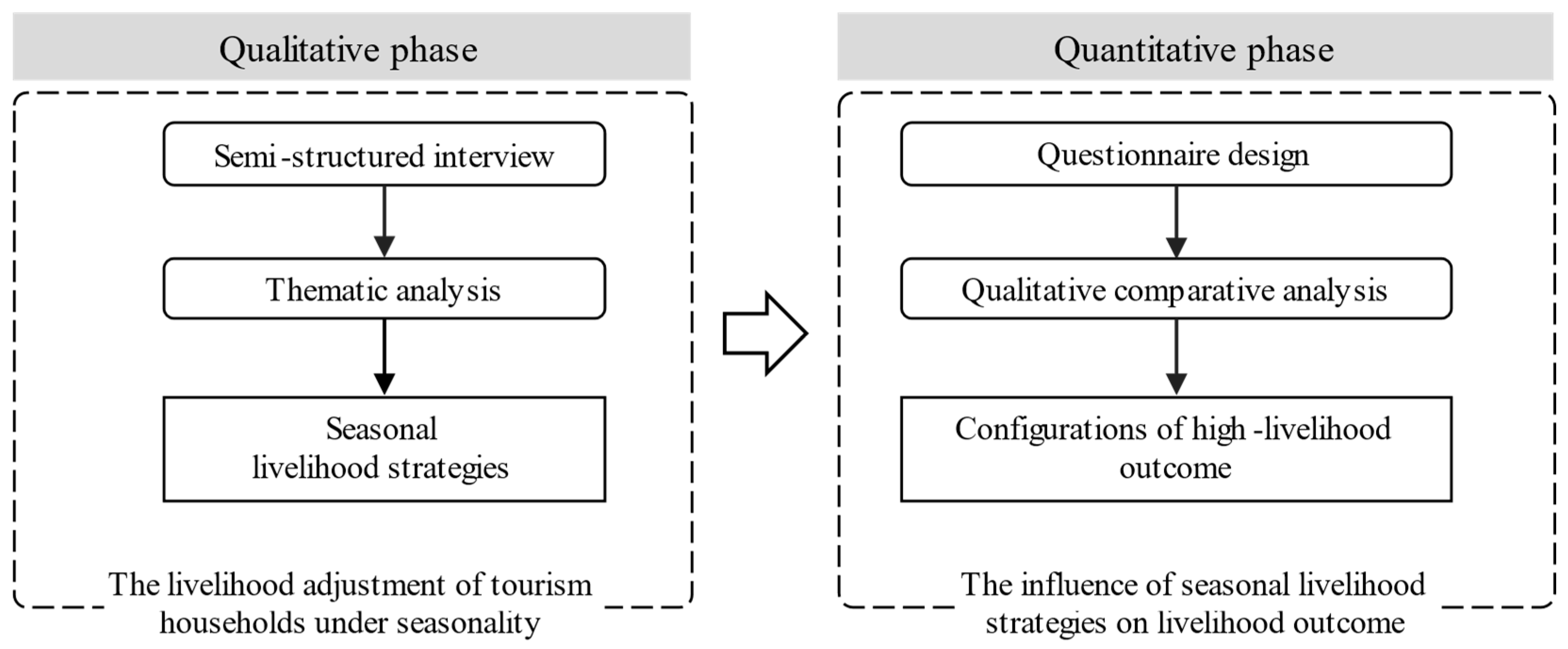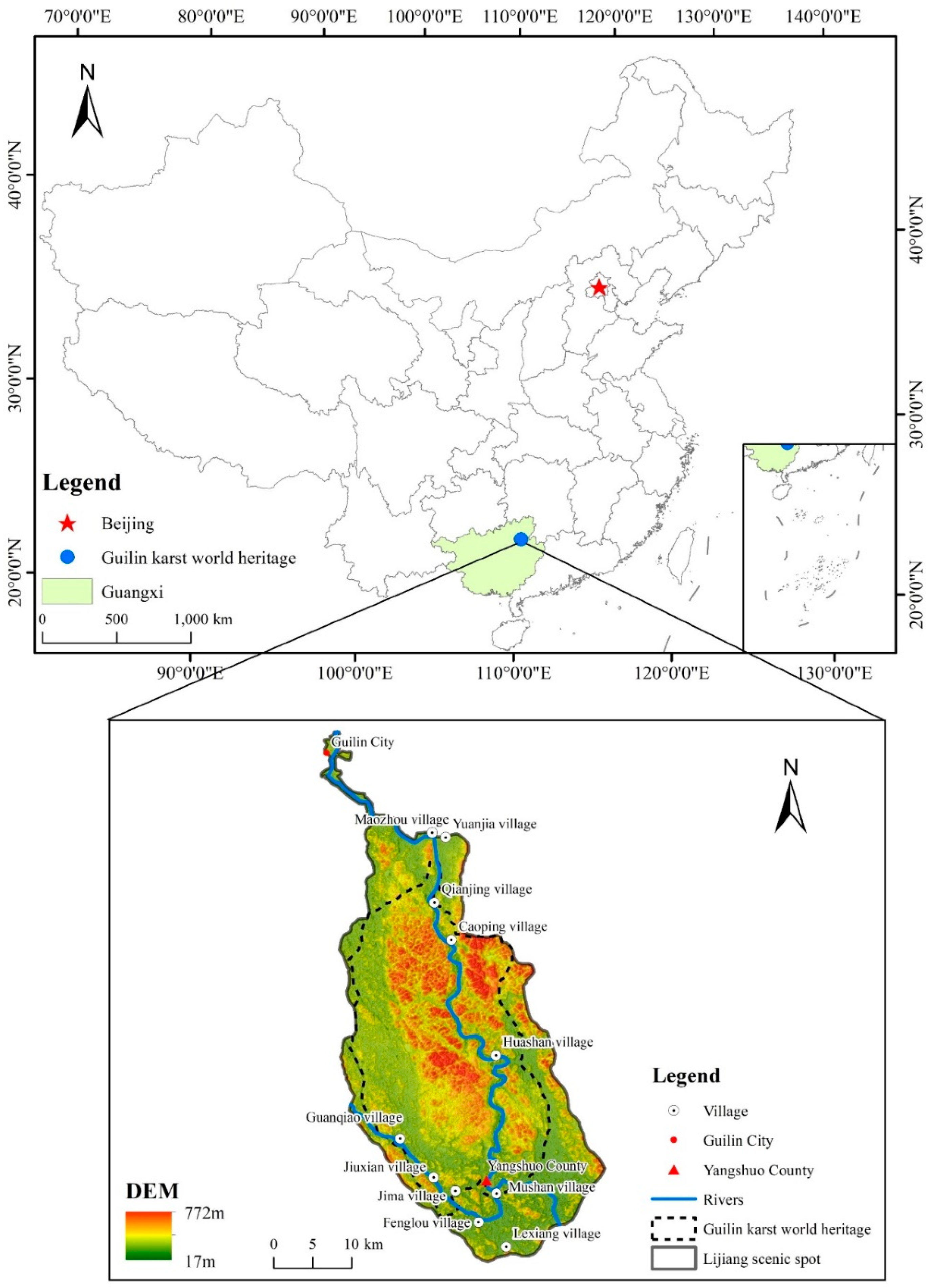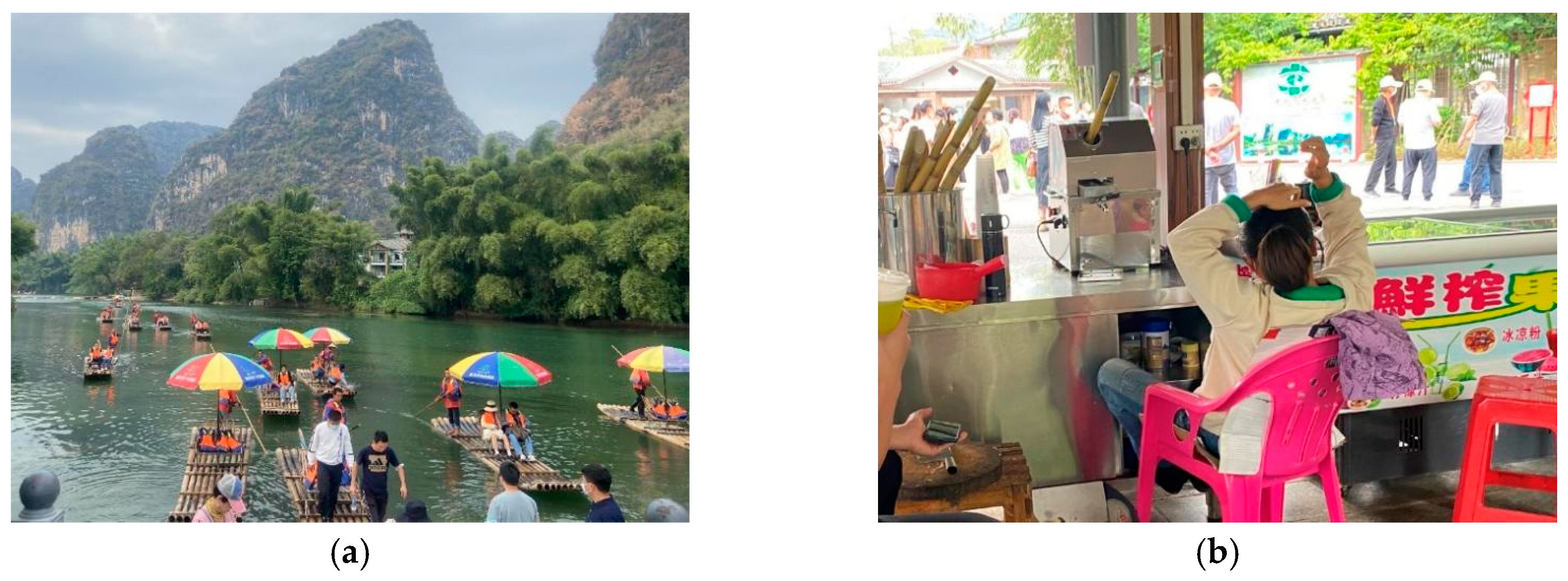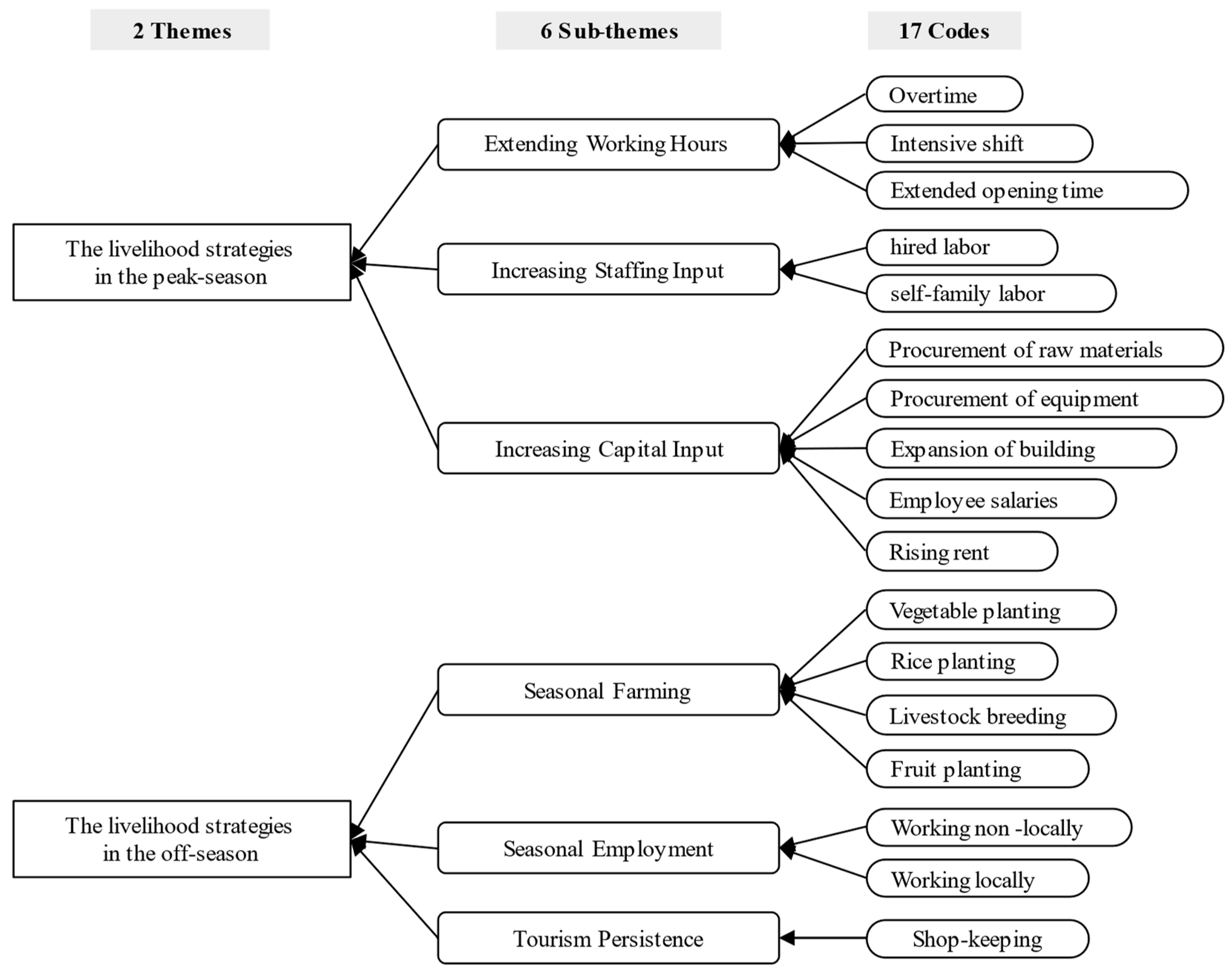Submitted:
23 August 2023
Posted:
24 August 2023
You are already at the latest version
Abstract
Keywords:
1. Introduction
2. Literature review
2.1. Sustainable livelihood
2.2. Tourism seasonality
3. Materials and Methods
3.1. Qualitative phase
3.2. Quantitative phase
3.2.1. Questionnaire design
3.2.2. FsQCA
3.2.3. Study area
4. Results
4.1. Seasonal livelihood strategies of rural tourism households
4.1.1. Off-season livelihood strategies
4.1.1.1. Tourism Persistence
4.1.1.2. Seasonal Farming
4.1.1.3. Seasonal Employment
4.1.2. Peak season livelihood strategies
4.1.2.1. Extending Working Hours
4.1.2.2. Increasing Staffing Input
4.1.2.3. Increasing Capital Input
4.2. The relationship between seasonal livelihood strategies and livelihood outcome
4.2.1. Individual necessary conditions
4.2.2. Analysis of sufficiency
4.2.3. Robustness analysis
5. Discussion
5.1. Discussion of Empirical Results
5.2. Implications
5.3. Limitations
6. Conclusion
Author Contributions
Funding
Institutional Review Board Statement
Informed Consent Statement
Data Availability Statement
Acknowledgments
Conflicts of Interest
Appendix A Household livelihood capital index
| Indicators | Sub-indicators | Interpretation and Assignment |
| Natural capital | Cultivated land resources | Cultivated land area assignment(0mu =0;0mu<area<5mu =0.5;5mu≤area<10mu =0.75;10mu≤area =1)× Cultivated land quality assignment(very good=1,relatively good=0.75,general=0.5) |
| Orchard land resources | Orchard land area assignment(0mu =0;0mu<area<5mu =0.5;5mu≤area<10mu =0.75;10mu≤area =1)× Orchard land quality assignment(very good=1,relatively good=0.75,general=0.5) | |
| Woodland resources | Woodland area assignment(0mu =0;0mu<area<5mu =0.5;5mu≤area<10mu =0.75;10mu≤area =1)× Woodland quality assignment(very good=1,relatively good=0.75,general=0.5) | |
| Physical capital | Housing resources | Distance from the main road: Less than 25m=1,25-50m=0.75,50-75m=0.5, More than 75m=0.25 |
| Area:More than 150 m2 =1,100-150 m2 =0.75,50-100 m2 =0.5,Less than 50 m2 =0.25 | ||
| Structure:Civil house =0.25,Brick and wood house=0.5,Brick and concrete house=0.75,Concrete house=1 | ||
| Age:Within 5 years=1,5-10 years=0.75,10-20 years=0.5,More than 20 years=0.25 | ||
| Floor:One=0.25,Two=0.5,Three=0.75,Four and above=1 | ||
| Durable goods | Truck=1,Car=0.8,Agricultural machinery =0.6,Motorcycle/Electric motorcycle =0.4,Other appliances =0.2 | |
| Human capital | Population size | Number of household size |
| Educational attainment | Each member's educational background:Below primary school=0,Primary school=0.25,Junior high school=0.5,High school=0.75,College and above=1 | |
| Labor force | Full labor force=1,Half labor force=0.5,Non labor force=0 | |
| Social capital | Social Connections | Whether there are village(town and above) cadres among relatives and friends:Yes=1,No=0 |
| Community relations | Frequency of participation in community activities:Frequently=1,Sometimes=0.5,Seldom=0 | |
| Frequency of contact with neighbors:Frequently=1,Sometimes=0.5,Seldom=0 | ||
| Access to relief | Relatives and friends=1,Relatives or friends=0.5,None=0 | |
| Government training opportunities | Whether received free skills training from the government: Yes=1,No=0 | |
| Financial capital | Government subsidies | Whether accepted subsidies from the government: Yes=1, No=0 |
| Difficulty of loaning | Easy=1,General =0.5,Difficult=0 | |
| Income sources | Four and above=1,Three=0.75, Two=0.5, One=0.25,Zero=0 |
References
- Mowforth, M.; Munt, I. , Tourism and sustainability: Development, globalisation and new tourism in the third world. 2015: routledge.
- Li, M.; Wu, B.; Cai, L. Tourism development of World Heritage Sites in China: A geographic perspective. Tour. Manag. 2008, 29, 308–319. [Google Scholar] [CrossRef]
- Su, M.M.; Wall, G.; Wang, S. Yujiale fishing tourism and island development in Changshan Archipelago, Changdao, China. Isl. Stud. J. 2017, 12, 127–142. [Google Scholar] [CrossRef]
- Qin, R.J.; Leung, H.H. Becoming a Traditional Village: Heritage Protection and Livelihood Transformation of a Chinese Village. Sustainability 2021, 13, 2331. [Google Scholar] [CrossRef]
- Mbaiwa, J.E. Changes on traditional livelihood activities and lifestyles caused by tourism development in the Okavango Delta, Botswana. Tour. Manag. 2011, 32, 1050–1060. [Google Scholar] [CrossRef]
- Rongna, A.; Sun, J. Integration and sustainability of tourism and traditional livelihood: A rhythmanalysis. J. Sustain. Tour. 2020, 28, 455–474. [Google Scholar] [CrossRef]
- Ashley, C. , The impacts of tourism on rural livelihoods: Namibia's experience. 2000.
- Huang, L.; Yang, L.; Tuyến, N.T.; Colmekcioglu, N.; Liu, J. Factors influencing the livelihood strategy choices of rural households in tourist destinations. J. Sustain. Tour. 2021, 30, 875–896. [Google Scholar] [CrossRef]
- Peng, W.; Zheng, H.; Robinson, B.E.; Li, C.; Wang, F. Household Livelihood Strategy Choices, Impact Factors, and Environmental Consequences in Miyun Reservoir Watershed, China. Sustainability 2017, 9, 175. [Google Scholar] [CrossRef]
- Tao, T.C.; Wall, G. Tourism as a sustainable livelihood strategy. Tour. Manag. 2009, 30, 90–98. [Google Scholar] [CrossRef]
- DfID, U. , Sustainable livelihoods guidance sheets. London: DFID, 1999, 445.
- Ellis, F. The Determinants of Rural Livelihood Diversification in Developing Countries. J. Agric. Econ. 2008, 51, 289–302. [Google Scholar] [CrossRef]
- Devereux, S.; Sabates-Wheeler, R.; Longhurst, R. Seasonality, rural livelihoods and development. 2013: Routledge.
- Shen, F.; et al. Connecting the Sustainable Livelihoods Approach and Tourism: A Review of the Literature. Journal of Hospitality & Tourism Management 2008. [Google Scholar]
- Ellis, F. Household strategies and rural livelihood diversification. J. Dev. Stud. 1998, 35, 1–38. [Google Scholar] [CrossRef]
- Lasso, A.; Dahles, H. Are tourism livelihoods sustainable? Tourism development and economic transformation on Komodo Island, Indonesia. Asia Pac. J. Tour. Res. 2018, 23, 473–485. [Google Scholar] [CrossRef]
- Rongna, A.; Sun, J. Tourism livelihood transition and rhythmic sustainability: The case of the Reindeer Evenki in China. Ann. Tour. Res. 2022, 94, 103381. [Google Scholar] [CrossRef]
- Chambers, R.; Conway, G.R. Sustainable rural livelihoods: Practical concepts for the 21st century. International Water Management Institute, 1991.
- Burbano, D.V.; Meredith, T.C. Effects of tourism growth in a UNESCO World Heritage Site: resource-based livelihood diversification in the Galapagos Islands, Ecuador. J. Sustain. Tour. 2020, 29, 1270–1289. [Google Scholar] [CrossRef]
- Qian, C.; Sasaki, N.; Jourdain, D.; Kim, S.M.; Shivakoti, P. Local livelihood under different governances of tourism development in China – A case study of Huangshan mountain area. Tour. Manag. 2017, 61, 221–233. [Google Scholar] [CrossRef]
- Ma, X.; Wang, R.; Dai, M.; Ou, Y. The influence of culture on the sustainable livelihoods of households in rural tourism destinations. J. Sustain. Tour. 2020, 29, 1235–1252. [Google Scholar] [CrossRef]
- Tao, T.C.-H. , Tourism as a livelihood strategy in indigenous communities: Case studies from Taiwan. 2006.
- Su, M.M.; Wall, G.; Wang, Y. Integrating tea and tourism: a sustainable livelihoods approach. J. Sustain. Tour. 2019, 27, 1591–1608. [Google Scholar] [CrossRef]
- Iorio, M.; Corsale, A. Rural tourism and livelihood strategies in Romania. J. Rural. Stud. 2010, 26, 152–162. [Google Scholar] [CrossRef]
- Jamal, K.; Banafsheh, N. The Effects of Rural Tourism on Sustainable Livelihoods (Case Study: Lavij Rural, Iran). Modern Applied ence, 2016, 10, 10–22. [Google Scholar]
- Xi, J.; Zhang, N. An analysis of the sustainable livelihood of tourism households: a case study in Gougezhuang village, Yesanpo tourism area. Tourism tribune, 2016, 31, 65–75. [Google Scholar]
- Mbaiwa, J.E.; Stronza, A.L. The effects of tourism development on rural livelihoods in the Okavango Delta, Botswana. J. Sustain. Tour. 2010, 18, 635–656. [Google Scholar] [CrossRef]
- Rongna, A.; Sun, J. Tourism livelihood transition and rhythmic sustainability: The case of the Reindeer Evenki in China. Ann. Tour. Res. 2022, 94, 103381. [Google Scholar] [CrossRef]
- Ellis, F. , Household strategies and rural livelihhod diversification. pdf. 1998.
- Ellis, F.; Mdoe, N. Livelihoods and Rural Poverty Reduction in Tanzania. World Dev. 2003, 31, 1367–1384. [Google Scholar] [CrossRef]
- Alemu, Z.G. Livelihood Strategies in Rural South Africa: Implications for Poverty Reduction. in International Association of Agricultural Economists. 2012.
- Huang, T.; Xi, J.-C.; Ge, Q.-S. Livelihood differentiation between two villages in Yesanpo Tourism District in China. J. Mt. Sci. 2017, 14, 2359–2372. [Google Scholar] [CrossRef]
- Turner, S. Trading Old Textiles: the Selective Diversification of Highland Livelihoods in Northern Vietnam. Hum. Organ. 2007, 66, 389–404. [Google Scholar] [CrossRef]
- Su, M.M.; Wall, G.; Wang, Y.; Jin, M. Livelihood sustainability in a rural tourism destination - Hetu Town, Anhui Province, China. Tour. Manag. 2018, 71, 272–281. [Google Scholar] [CrossRef]
- Su, Z.; Wen, R.; Zeng, Y.; Ye, K.; Khotphat, T. The Influence of Seasonality on the Sustainability of Livelihoods of Households in Rural Tourism Destinations. Sustainability 2022, 14, 10572. [Google Scholar] [CrossRef]
- Su, Z.; Aaron, J.R.; Guan, Y.; Wang, H. Sustainable Livelihood Capital and Strategy in Rural Tourism Households: A Seasonality Perspective. Sustainability 2019, 11, 4833. [Google Scholar] [CrossRef]
- Butler, R. ; Seasonality in Tourism Issues Problems Teoksessa: Tourism The State of Art toim, A. Seaton, 332--339. 1994, Chichester, UK: Wiley & Son.
- Baron, R.R.V. , Seasonality in tourism: A guide to the analysis of seasonality and trends for policy making. 1975: Economist Intelligence Unit.
- Rudihartmann, Tourism, seasonality and social change. Leisure studies, 1986, 5, 25–33. [CrossRef]
- Williams, A.M.; Shaw, G. Tourism and economic development: Western European experiences. *: 1991, 1991. [Google Scholar]
- Fernández, J.A.S.; Martín, J.A.R.; Rey, M.d.S.O. Analysis of Tourism Seasonality as a Factor Limiting the Sustainable Development of Rural Areas. J. Hosp. Tour. Res. 2020, 44, 45–75. [Google Scholar] [CrossRef]
- Rosselló, J.; Sansó, A. Yearly, monthly and weekly seasonality of tourism demand: A decomposition analysis. Tour. Manag. 2017, 60, 379–389. [Google Scholar] [CrossRef]
- Hinch, T.; Hickey, G. Tourism attractions and seasonality: Spatial relationships in Alberta. Proceedings of the travel and tourism research association, Canadian Chapter, 1997, 69-76.
- Grant, M.; Human, B.; Le Pelley, B. Seasonality in British Tourist Authority & English Tourist Bord. Insights-Tourism Intelligence Papers. 9, 5.
- Higham, J.; Hinch, T. Tourism, sport and seasons: the challenges and potential of overcoming seasonality in the sport and tourism sectors. Tour. Manag. 2002, 23, 175–185. [Google Scholar] [CrossRef]
- Mourdoukoutas, P. Seasonal Employment, Seasonal Unemployment and Unemployment Compensation: The Case of the Tourist Industry of the Greek Islands. Am. J. Econ. Sociol. 1988, 47, 315–329. [Google Scholar] [CrossRef]
- Lee, C.; et al. , Seasonality in the Tourism Industry: Impacts and Strategies. 2008.
- Baum, T.; Lundtorp, S. Seasonality in Tourism: An Introduction. In Seasonality in Tourism; Elsevier BV, 2001; pp. 1–4.
- Duro, J.A.; Turrion-Prats, J. Tourism seasonality worldwide. Tourism Management Perspectives, 2019, 31, 38–53. [Google Scholar] [CrossRef]
- Brännäs, K.; Nordström, J. Tourist Accommodation Effects of Festivals. Tour. Econ. 2006, 12, 291–302. [Google Scholar] [CrossRef]
- Tolkach, D. ; B King, Strengthening Community-Based Tourism in a new resource-based island nation: Why and how? Tourism Management, 2015, 48, 386–398. [Google Scholar] [CrossRef]
- Cresswell, J.W.; Clark, V.L.P. Designing and conducting mixed methods research. 2011.
- Braun, V. ; V Clarke, Using thematic analysis in psychology. Qualitative research in psychology, 2006, 3, 77–101. [Google Scholar] [CrossRef]
- Braun, V.; Clarke, V. Reflecting on reflexive thematic analysis. Qual. Res. Sport Exerc. Health 2019, 11, 589–597. [Google Scholar] [CrossRef]
- Ragin, C.C. , The comparative method: Moving beyond qualitative and quantitative strategies. 2014: Univ of California Press.
- Ragin, C.C. , Redesigning social inquiry: Fuzzy sets and beyond. 2009: University of Chicago Press.
- Fiss, P.C. Building Better Causal Theories: A Fuzzy Set Approach to Typologies in Organization Research. Acad. Manag. J. 2011, 54, 393–420. [Google Scholar] [CrossRef]
- Coduras, A.; Clemente, J.A.; Ruiz, J. A novel application of fuzzy-set qualitative comparative analysis to GEM data. J. Bus. Res. 2016, 69, 1265–1270. [Google Scholar] [CrossRef]
- Du, Y.; Liu, Q.; Chen, K.; Xiao, R.; Li, S. Ecosystem of doing business, total factor productivity and multiple patterns of high-quality development of Chinese cities: A configurational research based on complex system view. Journal of Management World, 2022, 38, 127–145. [Google Scholar]
- Zhang, M.; Du, Y. ; Qualitative comparative analysis (QCA) in management organization research: position tactics directions Chin, J. Manag, 2019, 16, 1312–1323. [Google Scholar]
- Schneider, C.Q.; Wagemann, C. Set-theoretic methods for the social sciences: A guide to qualitative comparative analysis. 2012: Cambridge University Press.
- Rihoux, B.; Ragin, C. Configurational Comparative Methods: Qualitative Comparative Analysis (QCA) and Related Techniques. 2008. [Google Scholar] [CrossRef]
- Schneider, C.Q.; Wagemann, C. Doing justice to logical remainders in QCA: Moving beyond the standard analysis. Political Research Quarterly 2013, 211–220. [Google Scholar]
- Kirchherr, J.; Charles, K.J.; Walton, M.J. Multi-causal pathways of public opposition to dam projects in Asia: A fuzzy set qualitative comparative analysis (fsQCA). Glob. Environ. Chang. 2016, 41, 33–45. [Google Scholar] [CrossRef]
- Pappas, I.O.; Woodside, A.G. Fuzzy-set Qualitative Comparative Analysis (fsQCA): Guidelines for research practice in Information Systems and marketing. Int. J. Inf. Manag. 2021, 58, 102310. [Google Scholar] [CrossRef]
- Rogerson, C.M. Regional tourism in South Africa: A case of `mass tourism of the South'. GeoJournal 2004, 60, 229–237. [Google Scholar] [CrossRef]
- Scheyvens, R. and Russell, M., Tourism and poverty reduction in the South Pacific. 2009.
- C. , A.K.; Parajuli, R.B.T. Tourism and its impact on livelihood in Manaslu conservation area, Nepal. Environ. Dev. Sustain. 2014, 16, 1053–1063. [Google Scholar] [CrossRef]
- Guha, I.; Ghosh, S. Does tourism contribute to local livelihoods? A case study of tourism, poverty and conservation in the Indian Sundarbans. 2007: SANDEE.
- Kokkranikal, J.; Morrison, A. Community Networks and Sustainable Livelihoods in Tourism: The Role of Entrepreneurial Innovation. Tour. Plan. Dev. 2011, 8, 137–156. [Google Scholar] [CrossRef]
- Murphy, P. Tourism: a community approach. Methuen: New York and London. Tourism Review, 1985; 6, 9–10. [Google Scholar] [CrossRef]
- Getz, D.; Nilsson, P.A. Responses of family businesses to extreme seasonality in demand: the case of Bornholm, Denmark. Tour. Manag. 2004, 25, 17–30. [Google Scholar] [CrossRef]
- Shields, J.; Shelleman, J. Small business seasonality: Characteristics and management. Small Business Institute Journal, 2013, 9, 37–50. [Google Scholar]
- Muller, C. Hospitality technology: a review and reflection. Worldw. Hosp. Tour. Themes 2010, 2, 9–19. [Google Scholar] [CrossRef]
- Sangaran, G.; Jeetesh, K. The effects of job satisfaction towards employee turnover in the hotel industry: A case study of hotels in Kuala Lumpur City Center. J Tourism Hospit, 2015, 4, 2167–0269. [Google Scholar]
- Hung, R. Novel ways to deal with seasonal manpower needs. Work. Study 1998, 47, 87–89. [Google Scholar] [CrossRef]
- Bires, Z.; Raj, S. Tourism as a pathway to livelihood diversification: Evidence from biosphere reserves, Ethiopia. Tour. Manag. 2020, 81, 104159. [Google Scholar] [CrossRef]
- Mbaiwa, J.E.; Sakuze, L.K. Cultural tourism and livelihood diversification: The case of Gcwihaba Caves and XaiXai village in the Okavango Delta, Botswana. J. Tour. Cult. Chang. 2009, 7, 61–75. [Google Scholar] [CrossRef]
- Ateljevic, I.; Doorne, S. 'Staying Within the Fence': Lifestyle Entrepreneurship in Tourism. J. Sustain. Tour. 2000, 8, 378–392. [Google Scholar] [CrossRef]
- Li, Y.; Gong, P.; Ke, J. Development opportunities, forest use transition, and farmers' income differentiation: The impacts of Giant panda reserves in China. Ecol. Econ. 2020, 180, 106869. [Google Scholar] [CrossRef]
- Liu, S.; Cheung, L.T.O. Sense of place and tourism business development. Tour. Geogr. 2016, 18, 174–193. [Google Scholar] [CrossRef]
- Su, F.; Chang, J.; Shang, H. Coupling Coordination Analysis of Livelihood Efficiency and Land Use for Households in Poverty-Alleviated Mountainous Areas. Land 2021, 10, 1115. [Google Scholar] [CrossRef]




| Causal conditions | High livelihood outcome |
|---|---|
| Consistency | |
| Tourism Persistence | 0.885 |
| ~ Tourism Persistence | 0.115 |
| Seasonal Employment | 0.352 |
| ~ Seasonal Employment | 0.648 |
| Seasonal Farming | 0.306 |
| ~ Seasonal Farming | 0.694 |
| Extending Working Hours | 0.987 |
| ~ Extending Working Hours | 0.013 |
| Increasing Staffing Input | 0.812 |
| ~ Increasing Staffing Input | 0.188 |
| Increasing Capital Input | 0.112 |
| ~ Increasing Capital Input | 0.887 |
| Causal conditions | Configurations | |||
|---|---|---|---|---|
| S1a | S1b | S1c | S2 | |
| Tourism Persistence | ● | ● | ⓧ | |
| Seasonal Employment | ● | ● | ● | |
| Seasonal Farming | ⊗ | ⊗ | ● | |
| Extending Working Hours | ⬤ | ⬤ | ⬤ | ⬤ |
| Increasing Staffing Input | ⬤ | ⬤ | ⬤ | ⊗ |
| Increasing Capital Input | ⊗ | ⊗ | ⬤ | |
| Consistency | 0.895 | 0.945 | 0.953 | 0.915 |
| Row Coverage | 0.116 | 0.029 | 0.035 | 0.010 |
| Unique consistency | 0.097 | 0.010 | 0.016 | 0.010 |
| Overall consistency | 0.913 | |||
| Overall coverage | 0.152 | |||
Disclaimer/Publisher’s Note: The statements, opinions and data contained in all publications are solely those of the individual author(s) and contributor(s) and not of MDPI and/or the editor(s). MDPI and/or the editor(s) disclaim responsibility for any injury to people or property resulting from any ideas, methods, instructions or products referred to in the content. |
© 2023 by the authors. Licensee MDPI, Basel, Switzerland. This article is an open access article distributed under the terms and conditions of the Creative Commons Attribution (CC BY) license (https://creativecommons.org/licenses/by/4.0/).





